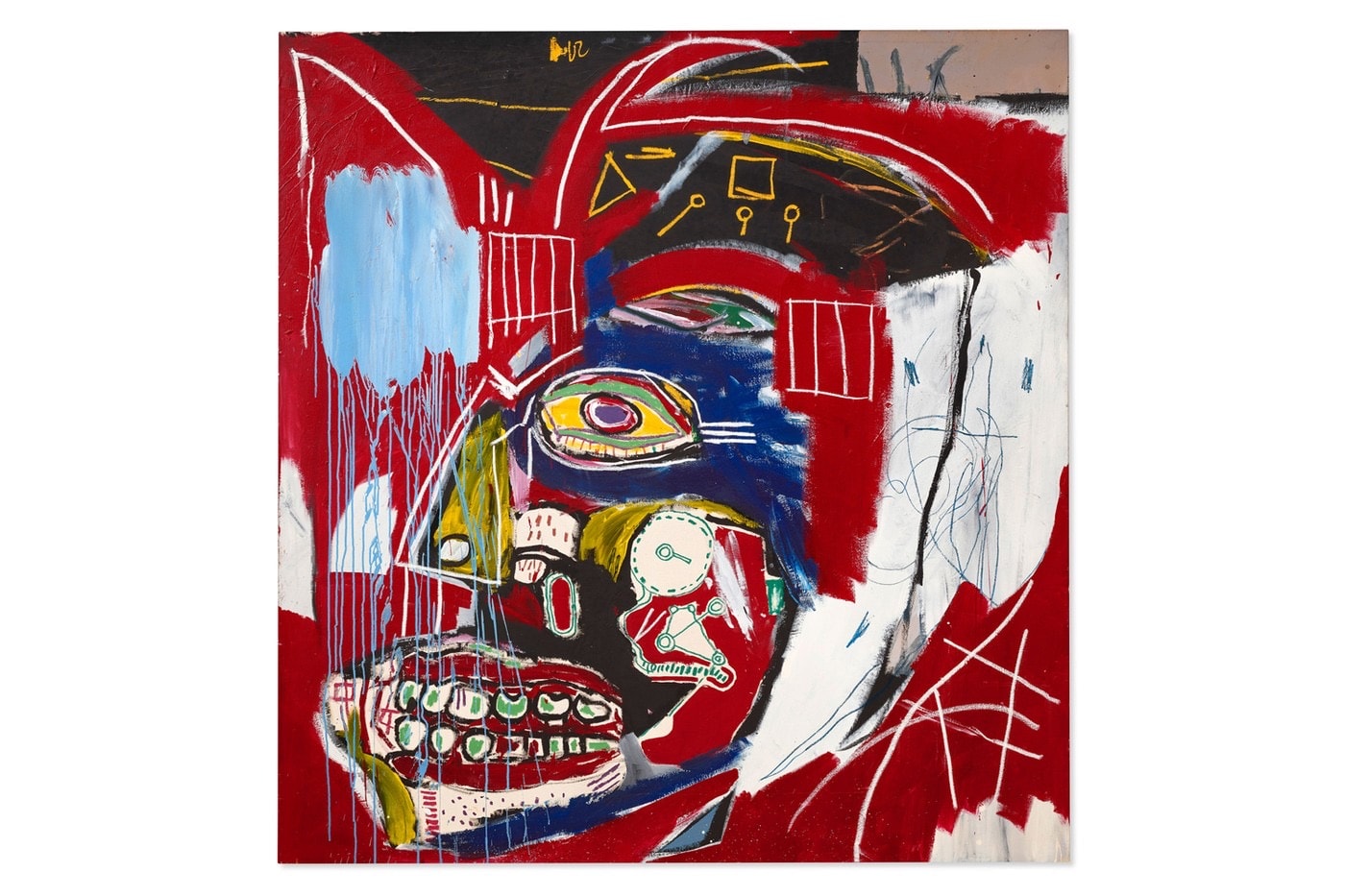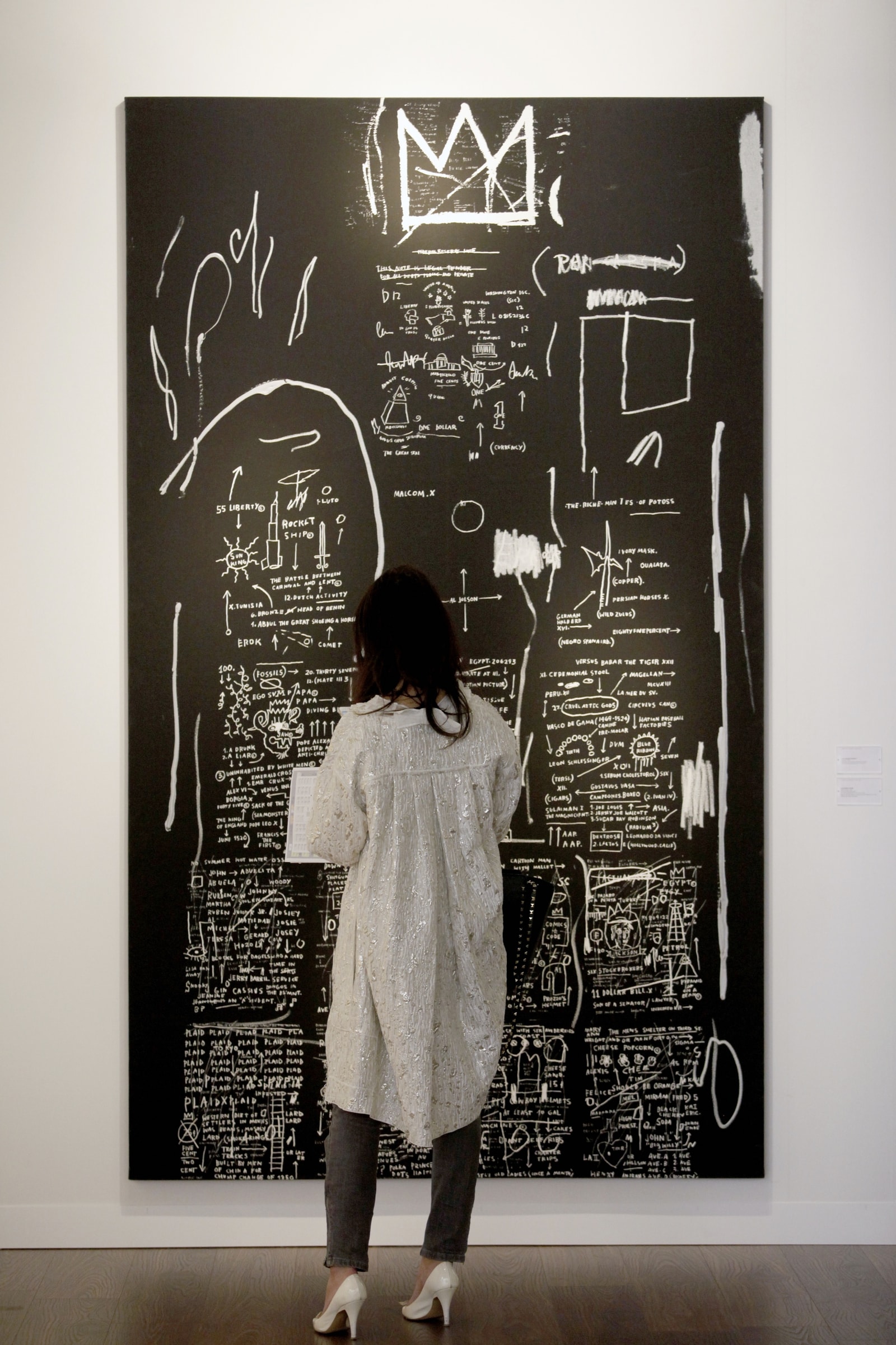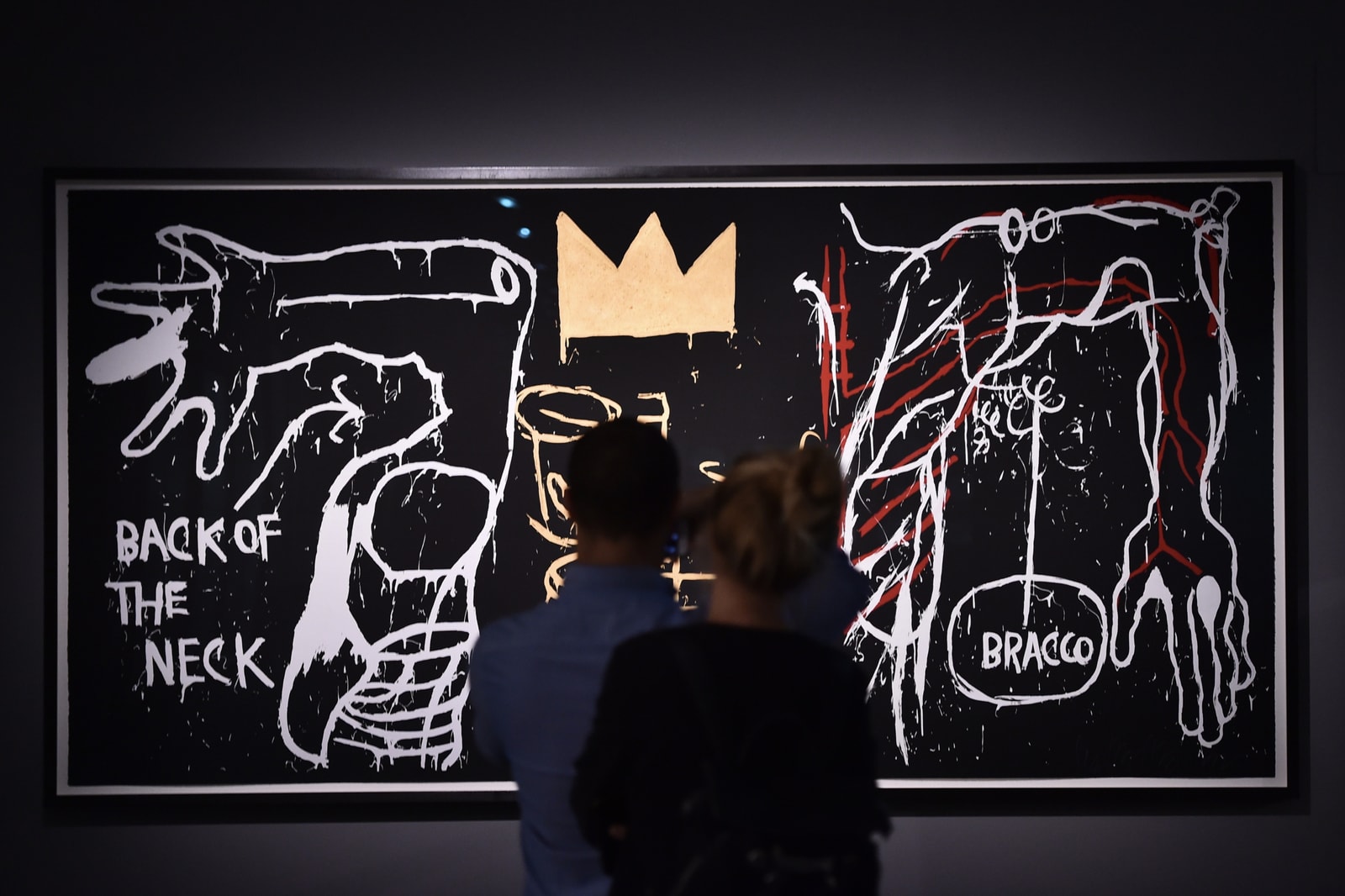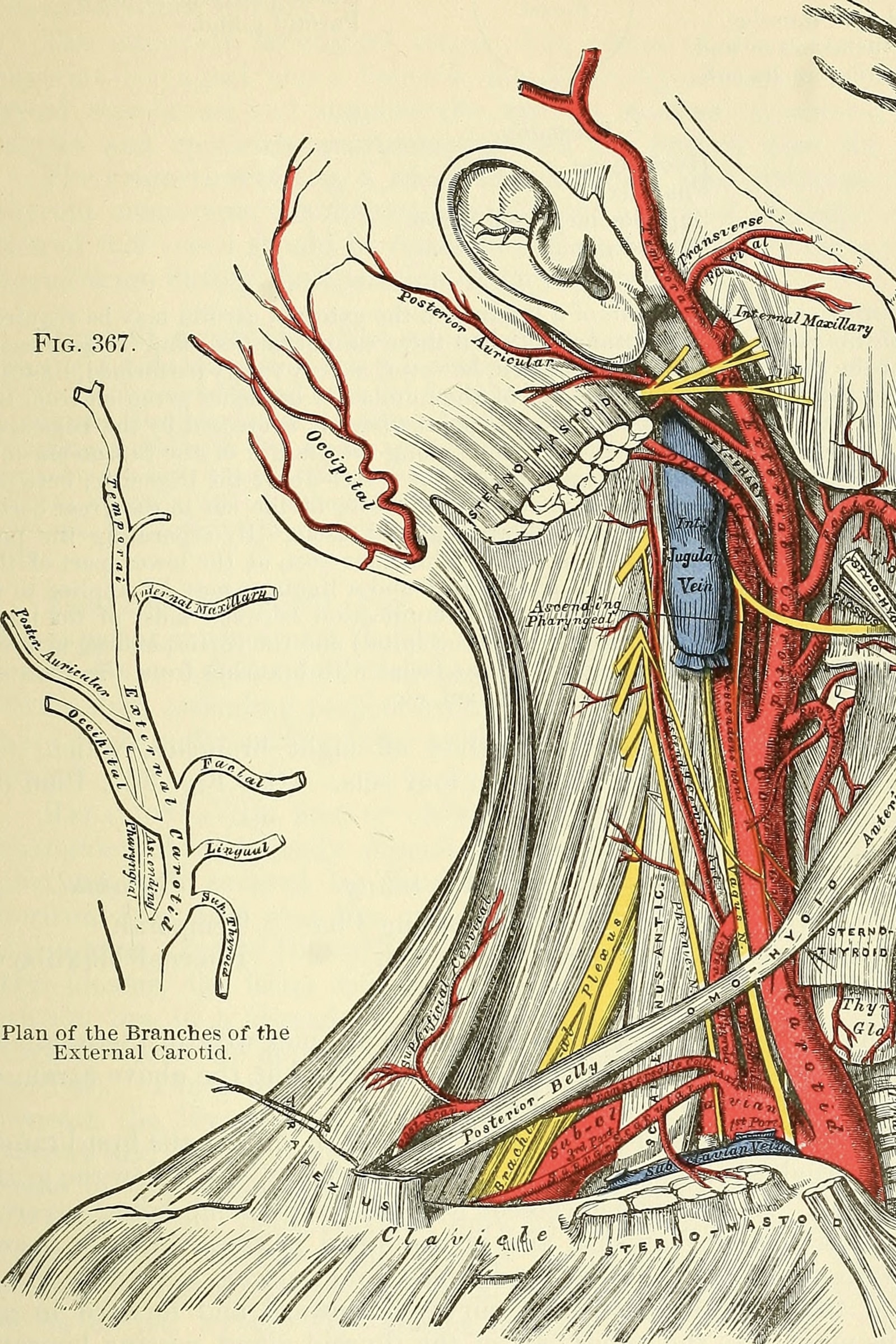Thirty-three years ago today, Jean Michel Basquiat was found lying in a Manhattan apartment due to an overdose. In a short ten-year artistic career, Basquiat’s creation has not only become a booster to revitalize the New York art scene in the early 1980s, but has even influenced popular culture for the past thirty years.
For a long time, whether it is its iconic symbol or himself, it has become an example of “overquoted” in popular culture. As for the thinking and beliefs behind Jean-Michel Basquiat’s works that constitute his artistic system, few people have discussed it. This time, HYPEBEAST will extract keywords from the four masterpieces of Jean-Michel Basquiat, and relive the mood of this meteor-like artist when he writes.
Dichotomies
Painting: “Untitled” 1983
Getty Images
Trying to understand the creation of Jean-Michel Basquiat, you have to analyze it from the perspective of a black artist. In the early 1980s, Basquiat entered the art world dominated by whites as a young black man. At that time, he was already well-known, and his works gradually moved from the streets to the elegantly decorated exhibition halls, but despite Basquiat’s repeated attempts I am obscuring my black identity and discussing my work in the context of art, but most critics cannot help but examine it in the stereotype of race.
This sign can be seen in an interview with Basquiat by the Greek artist Demosthenes Davvetas. The words “graffiti artist”, “fetish”, “tracing of African ancestry”, “cult”, etc. constantly appearing in the interview outline seem to imply that black artists must limit their discussions to these terms.
Basquiat’s thinking about the black situation in the white world and the white thinking in the black context has gradually evolved into a binary opposition strategy that constantly appears in his works. As a result, the artist inevitably discussed a lot of his own social observations and successful experiences about money, value, trade, commerce, race, and oppression in his works, but the fundamentally opposed ideas or beliefs expressed in his works, It is often more conceptual, such as the perception of self-worth and the marginalization of the self, the interaction between sacredness and scarcity, matter and reason. Not only does it play a role in his autobiographical themes, but historically renowned African-Americans such as Malcolm X, Langston Hughes and Marcus Garvey are often the subjects of his works.

《In This Case》Christie’s
Fred Hoffman confirmed this statement in the article “The Defining Years: Notes on Five Key Works”: “When I collaborated with Jean-Michel Basquiat on the production of his first silkscreen print, I was keenly aware that he intended to The duality of “black and white” is revealed in the work. ”
In “Untitled” released in 1983, Basquiat completed the drawing of the first draft. The mask, text, logo, and image in the screen were all finalized. However, he then reversed the black and white colors during the painting process, and changed the original The black part becomes white, and the white part becomes black. “This act is an attempt to convey a message to the world through “subverting black and white”: It is easy for him to turn a world dominated by whites into a world dominated by blacks. “Fred Hoffman said.
The Crown
Painting: “Tuxedo” 1983

Getty Images
As the most common pattern in Jean-Michel Basquiat’s works, the three-point crown has also become one of the most recognizable symbols in popular culture. From co-branded clothing to tattoo materials, the frequency with which this symbol is quoted or even misappropriated is enough to illustrate its influence.
To this day, art historians and commentators are still discussing the specific meaning behind this symbol. Even if everyone insists on their own words, the only thing that is certain is that the “power” symbolized by the “crown” must not be ignored. of.
In the book “True Colors: The Real Life of the Art World“, Jean-Michel Basquiat once revealed in an interview with Anthony Haden-Guest of the United States that he was fascinated by the “Power of Logo”, which was also his early art career The reason why the SAMO© graffiti tags are painted all over the SOHO block-before he officially enters the elegant art hall, he already has the ambition and desire to become famous, and a clear and powerful logo like a signature can help him do this , Both at the artistic level and the marketing level.

Murals left by Basquiat in the Lower East Side of New YorkGetty Images
At the same time, the existence of the crown is a signal of Jean-Michel Basquiat’s self-coronation. Whether it is the early streets or the palace of art, Jean-Michel Basquiat has expressed this view in works of different periods. “Red Kings” published in 1981 is often considered by art historians to be Jean’s self-portrait. The other “king” that also appears on his right is the artist Pablo Picasso who has already been on the altar. This is also the crown. Another meaning of: that is, a certain connection between Basquiat and those whom he considers to be the king.
Moreover, Basquiat, who rarely commented on his work, revealed to us the secrets under the crown in Tuxedo created in 1982. In this painting, Basquiat mixed, combined and layered text, images and some graphic materials, and finally spliced them into 15 highly structured and ordered panels. These interwoven networks of repeated phrases and images passed through arrows and ladders. Connect and guide the viewer’s sight to move from bottom to top, and finally fall on the crown at the top. These plates represent various political, historical, social, and cultural events related to African Americans, and the crown hovering above all time and material.
The symbolism expressed in this painting is often regarded as a summary statement of Jean-Michel Basquiat’s explosive creation between 1981 and 1983, that is, to put the African-American dilemma under a peaceful situation. Go to the table and give your own solution in the metaphor of the crown.
Anatomy Human Anatomy
Painting: “Untitled (Skull)” 1981

Getty Images
At the age of 7, Jean-Michel Basquiat suffered a car accident while playing softball on the streets of Brooklyn, which resulted in a broken arm and soft tissue contusions in multiple places. While recuperating in the hospital, his mother gave him a copy of “Gray’s Anatomy”. This book is full of detailed anatomical diagrams and diagrams. The observation of this reference book in his childhood was buried in Basquiat’s heart. An unnamed seed, he not only named GRAY the name of his first band, but also used the imagery of human anatomy many times in his later artistic career. His fascination with the field of anatomy was his first time. It was vividly reflected when he tried printmaking, and his two series “Anatomy” (1982) and “Untitled (from Leonardo)” (1983) exemplified this.
However, only in “Back of the Neck” (1983) did Basquiat piece together different limbs-not only the isolated human body illustration in “Gray’s Anatomy”, but a complete image.

“Gray’s Anatomy”Getty Images
“Back of the Neck” is one of the few silkscreen prints that Basquiat created in his lifetime. In the center of the composition, a hand-painted crown hovers over a deconstructed torso. On the left side of the screen, “Back of the Neck” outlines the artist’s iconic all-caps letters in chalk. This expression obviously refers to human anatomy, and as the Leonardo scholar Carlo Pedretti pointed out, “spine” Refers to “the position of the soul.” On both sides of the fragile spine are two dismembered arms: one is intact, and the other is left with muscles and tendons. The violent aesthetics of this torn limb comes from the violent aesthetics that permeated New York City that year. Violent emotions.
In 1983, 25-year-old black graffiti artist Michael Stewart was arrested and beaten to death while being detained by the New York police. As a black artist born on the street, Jean-Michel Basquiat not only denounced the violent politics surrounding black people with torn limbs, but also placed the crown on this damaged black body, which inevitably caused viewers to produce a kind of “martyrdom.” The tragic emotions.
Live Fast, Die young
画作:《Riding with Death》1988

Getty Images
“Riding with Death” is different from the fanatical and rich compositional elements in previous works. As the name implies, an African-American in the picture is riding a white skeleton. The face of the skeleton looks directly at the audience, on his back The body of black people has gradually begun to be decomposed. Jean Michel Basquiat completed this painting with such a simple composition, but it does not affect the racism, social issues, reversal of the power structure, the texture of African tribal murals, and death. All of the references imply a pessimistic attitude.
This simple composition is not common in the artist’s career, but if you consider that the painting successfully predicted the death of the author Jean-Michel Basquiat a few months later, everything seems to make sense.
Michael Holman, Basquiat’s former band (GRAY) partner, recalled this old friend when he said: “He always said that he would leave this world at the age of twenty-seven, because Jimi Hendrix, Jim Morrison and Janis Joplin are also similar. When I pass away, I just want to live in the present.” And as we know, Jean-Michel Basquiat walked into his prophecy in a self-destructive way at the age of 27.
In the early spring of next year, Basquiat’s family will hold an art exhibition called “Jean-Michel Basquiat: King Pleasure” in New York, showing up to 200 works of art that have never been exposed during his lifetime.
Even during his lifetime, Basquiat was often noncommittal about the outside world‘s interpretation of his works. The world can only piece together the artist’s thinking through the research of art historians and rare works and materials.
As the layout of his work gradually emerges, we may be able to see a more vivid Jean-Michel Basquiat.
